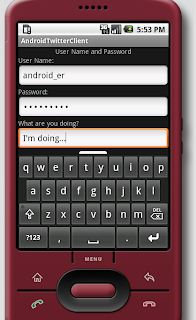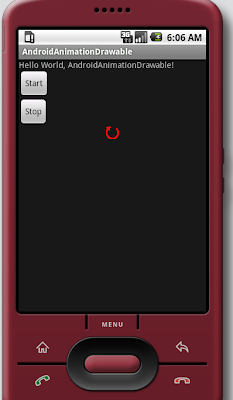The folowing example used to list all the video files stored in SDcard and you can
play the video by selecting the file from list.
AndroidManifest.xml
--------------------
<?xml version="1.0" encoding="utf-8"?>
< manifest xmlns:android="http://schemas.android.com/apk/res/android"
package="sample.video" android:versionCode="1" android:versionName="1.0.0">
< uses-permission android:name="android.permission.MOUNT_UNMOUNT_FILESYSTEMS" />
< application android:icon="@drawable/icon" android:label="@string/app_name">
< activity android:name=".VideoActivity" android:label="@string/app_name">
< intent-filter>
< action android:name="android.intent.action.MAIN" />
< category android:name="android.intent.category.LAUNCHER"/>
< /intent-filter>
</activity>
< activity android:name=".ViewVideo">
< intent-filter>
< action android:name="android.intent.action.VIEW" />
< category android:name="android.intent.category.DEFAULT" />
</intent-filter>
</activity>
</application>
</manifest>
main.xml
--------
<?xml version="1.0" encoding="utf-8"?>
< LinearLayout xmlns:android="http://schemas.android.com/apk/res/android"
android:orientation="vertical" android:layout_width="fill_parent"
android:layout_height="fill_parent">
< ListView
android:id="@+id/PhoneVideoList"
android:layout_width="fill_parent"
android:layout_height="fill_parent"/>
</LinearLayout>
VideoActivity.java
-------------------
package sample.video;
import android.app.Activity;
import android.content.Context;
import android.content.Intent;
import android.database.Cursor;
import android.os.Bundle;
import android.provider.MediaStore;
import android.view.View;
import android.view.ViewGroup;
import android.widget.AdapterView;
import android.widget.BaseAdapter;
import android.widget.ListView;
import android.widget.TextView;
import android.widget.AdapterView.OnItemClickListener;
public class VideoActivity extends Activity {
private Cursor videocursor;
private int video_column_index;
ListView videolist;
int count;
/** Called when the activity is first created. */
@Override
public void onCreate(Bundle savedInstanceState) {
super.onCreate(savedInstanceState);
setContentView(R.layout.main);
init_phone_video_grid();
}
private void init_phone_video_grid() {
System.gc();
String[] proj = { MediaStore.Video.Media._ID,
MediaStore.Video.Media.DATA,
MediaStore.Video.Media.DISPLAY_NAME,
MediaStore.Video.Media.SIZE };
videocursor = managedQuery(MediaStore.Video.Media.EXTERNAL_CONTENT_URI,
proj, null, null, null);
count = videocursor.getCount();
videolist = (ListView) findViewById(R.id.PhoneVideoList);
videolist.setAdapter(new VideoAdapter(getApplicationContext()));
videolist.setOnItemClickListener(videogridlistener);
}
private OnItemClickListener videogridlistener = new OnItemClickListener() {
public void onItemClick(AdapterView parent, View v, int position,
long id) {
System.gc();
video_column_index = videocursor
.getColumnIndexOrThrow(MediaStore.Video.Media.DATA);
videocursor.moveToPosition(position);
String filename = videocursor.getString(video_column_index);
Intent intent = new Intent(VideoActivity.this, ViewVideo.class);
intent.putExtra("videofilename", filename);
startActivity(intent);
}
};
public class VideoAdapter extends BaseAdapter {
private Context vContext;
public VideoAdapter(Context c) {
vContext = c;
}
public int getCount() {
return count;
}
public Object getItem(int position) {
return position;
}
public long getItemId(int position) {
return position;
}
public View getView(int position, View convertView, ViewGroup parent) {
System.gc();
TextView tv = new TextView(vContext.getApplicationContext());
String id = null;
if (convertView == null) {
video_column_index = videocursor
.getColumnIndexOrThrow(MediaStore.Video.Media.DISPLAY_NAME);
videocursor.moveToPosition(position);
id = videocursor.getString(video_column_index);
video_column_index = videocursor
.getColumnIndexOrThrow(MediaStore.Video.Media.SIZE);
videocursor.moveToPosition(position);
id += " Size(KB):" + videocursor.getString(video_column_index);
tv.setText(id);
} else
tv = (TextView) convertView;
return tv;
}
}
}
ViewVideo.java
---------------
package sample.video;
import android.app.Activity;
import android.content.Intent;
import android.os.Bundle;
import android.widget.MediaController;
import android.widget.VideoView;
public class ViewVideo extends Activity {
private String filename;
@Override
public void onCreate(Bundle savedInstanceState) {
super.onCreate(savedInstanceState);
System.gc();
Intent i = getIntent();
Bundle extras = i.getExtras();
filename = extras.getString("videofilename");
VideoView vv = new VideoView(getApplicationContext());
setContentView(vv);
vv.setVideoPath(filename);
vv.setMediaController(new MediaController(this));
vv.requestFocus();
vv.start();
}
}
play the video by selecting the file from list.
AndroidManifest.xml
--------------------
<?xml version="1.0" encoding="utf-8"?>
< manifest xmlns:android="http://schemas.android.com/apk/res/android"
package="sample.video" android:versionCode="1" android:versionName="1.0.0">
< uses-permission android:name="android.permission.MOUNT_UNMOUNT_FILESYSTEMS" />
< application android:icon="@drawable/icon" android:label="@string/app_name">
< activity android:name=".VideoActivity" android:label="@string/app_name">
< intent-filter>
< action android:name="android.intent.action.MAIN" />
< category android:name="android.intent.category.LAUNCHER"/>
< /intent-filter>
</activity>
< activity android:name=".ViewVideo">
< intent-filter>
< action android:name="android.intent.action.VIEW" />
< category android:name="android.intent.category.DEFAULT" />
</intent-filter>
</activity>
</application>
</manifest>
main.xml
--------
<?xml version="1.0" encoding="utf-8"?>
< LinearLayout xmlns:android="http://schemas.android.com/apk/res/android"
android:orientation="vertical" android:layout_width="fill_parent"
android:layout_height="fill_parent">
< ListView
android:id="@+id/PhoneVideoList"
android:layout_width="fill_parent"
android:layout_height="fill_parent"/>
</LinearLayout>
VideoActivity.java
-------------------
package sample.video;
import android.app.Activity;
import android.content.Context;
import android.content.Intent;
import android.database.Cursor;
import android.os.Bundle;
import android.provider.MediaStore;
import android.view.View;
import android.view.ViewGroup;
import android.widget.AdapterView;
import android.widget.BaseAdapter;
import android.widget.ListView;
import android.widget.TextView;
import android.widget.AdapterView.OnItemClickListener;
public class VideoActivity extends Activity {
private Cursor videocursor;
private int video_column_index;
ListView videolist;
int count;
/** Called when the activity is first created. */
@Override
public void onCreate(Bundle savedInstanceState) {
super.onCreate(savedInstanceState);
setContentView(R.layout.main);
init_phone_video_grid();
}
private void init_phone_video_grid() {
System.gc();
String[] proj = { MediaStore.Video.Media._ID,
MediaStore.Video.Media.DATA,
MediaStore.Video.Media.DISPLAY_NAME,
MediaStore.Video.Media.SIZE };
videocursor = managedQuery(MediaStore.Video.Media.EXTERNAL_CONTENT_URI,
proj, null, null, null);
count = videocursor.getCount();
videolist = (ListView) findViewById(R.id.PhoneVideoList);
videolist.setAdapter(new VideoAdapter(getApplicationContext()));
videolist.setOnItemClickListener(videogridlistener);
}
private OnItemClickListener videogridlistener = new OnItemClickListener() {
public void onItemClick(AdapterView parent, View v, int position,
long id) {
System.gc();
video_column_index = videocursor
.getColumnIndexOrThrow(MediaStore.Video.Media.DATA);
videocursor.moveToPosition(position);
String filename = videocursor.getString(video_column_index);
Intent intent = new Intent(VideoActivity.this, ViewVideo.class);
intent.putExtra("videofilename", filename);
startActivity(intent);
}
};
public class VideoAdapter extends BaseAdapter {
private Context vContext;
public VideoAdapter(Context c) {
vContext = c;
}
public int getCount() {
return count;
}
public Object getItem(int position) {
return position;
}
public long getItemId(int position) {
return position;
}
public View getView(int position, View convertView, ViewGroup parent) {
System.gc();
TextView tv = new TextView(vContext.getApplicationContext());
String id = null;
if (convertView == null) {
video_column_index = videocursor
.getColumnIndexOrThrow(MediaStore.Video.Media.DISPLAY_NAME);
videocursor.moveToPosition(position);
id = videocursor.getString(video_column_index);
video_column_index = videocursor
.getColumnIndexOrThrow(MediaStore.Video.Media.SIZE);
videocursor.moveToPosition(position);
id += " Size(KB):" + videocursor.getString(video_column_index);
tv.setText(id);
} else
tv = (TextView) convertView;
return tv;
}
}
}
ViewVideo.java
---------------
package sample.video;
import android.app.Activity;
import android.content.Intent;
import android.os.Bundle;
import android.widget.MediaController;
import android.widget.VideoView;
public class ViewVideo extends Activity {
private String filename;
@Override
public void onCreate(Bundle savedInstanceState) {
super.onCreate(savedInstanceState);
System.gc();
Intent i = getIntent();
Bundle extras = i.getExtras();
filename = extras.getString("videofilename");
VideoView vv = new VideoView(getApplicationContext());
setContentView(vv);
vv.setVideoPath(filename);
vv.setMediaController(new MediaController(this));
vv.requestFocus();
vv.start();
}
}



























